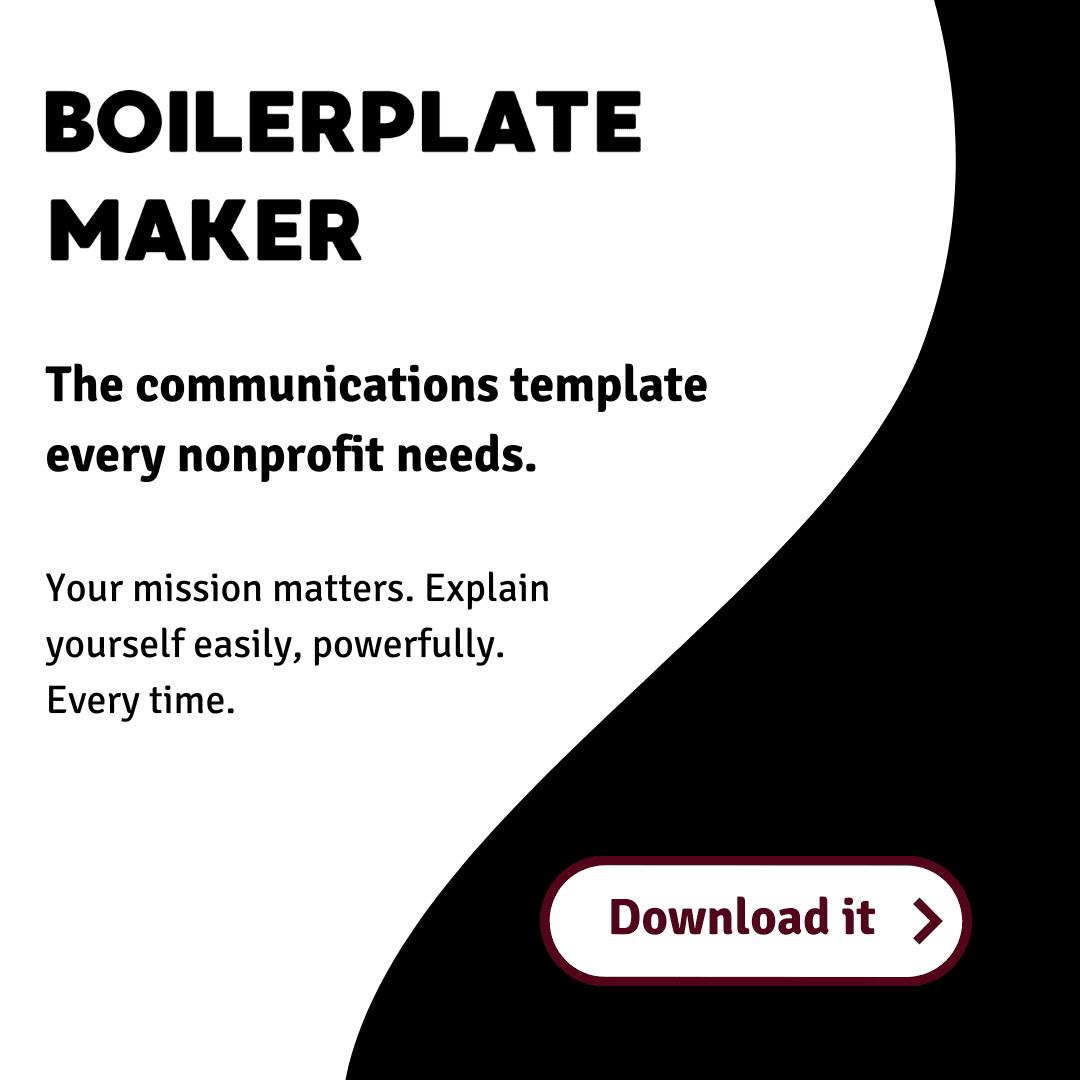The Organizer #2 | Communications
| How do I explain what my nonprofit does and why it matters? | Create some boilerplate language so you don't have to start from scratch every day. Entremission's boilerplate guide can help. |
Explain yourself easily with boilerplate language
We need to talk about the reality of nonprofit communications. Sure, passion and personality matter. But so do preparation and paperwork … and that means you need boilerplate language.
People think social impact communications is all about passion and personality. They picture a charismatic speaker on the steps of Congress or Parliament Hill. Their speaker addresses a cluster of TV cameras and microphones. Then they raise their eyes to the crowd of rapt and attentive onlookers beyond. Words flow from the speaker’s lips, inspiring the audience first to cheers and then to action.
That’s what people think social impact communications looks like.
The reality is quite different.

Get the boilerplate guide
Real communications looks like this
A pile of papers covers a kitchen table. A weary executive director is editing four different documents. Each document describes the organization differently. Each is littered with edits in red ink, edits that make sure the language meets government, funder, legal, and campaign requirements. All are due this week. She rubs her eyes.
Meanwhile, in a dimly-lit office a new communications specialist is searching Google Drive in vain. They need information to finish tomorrow’s press release, but the program staff are all in the field and the “helpful resources” folder is empty. Their phone rings. It’s a board member saying “Hey. I’m walking into lunch with a potential donor. What should I say we do?” The comms person, like the drive folder, has nothing to say.
A few feet away, a grants officer bangs on his keyboard in frustration. “How can I fit 25 years of history into 25 characters! This is impossible!” He pushes back from his desk, grabs his coat, and leaves in search of coffee. The grant proposal will have to wait.
A hundred miles away, the intern no one has met is also looking at a computer screen. She’s staring at a document called “About Page for New Website”. She is trying not to let the blinking cursor on the empty page panic her. She loads Twitter in another tab, searching for clues. The bio promotes a (cancelled) event from June 2020. She doesn’t know where to turn next.
No judgement, here. You find yourself scrambling because there is too much to do and not enough time or people to do it. In many organizations, that executive director, comms specialist, grant officer, and intern are all the same person. It’s a lot. Boilerplate language can help.
Communications takes work, but it doesn’t have to be so hard
Whether you are a team of one or a team of 50, there are resources you can create that will save enormous amounts of time and mental bandwidth. At a minimum, you should have one file that includes a description of your organization and its mission. Let people copy and paste this every time they need to explain your work, and life will get easier overnight.
This is a bold claim. But how many times a week do you really want to answer questions like “What is your purpose? What is your mission? What have you accomplished?”
If you could get through the next few days without going on an existential odyssey, wouldn’t that be great? If you could save yourself an hour a week, what would you do with that time? If you could make it easier for more people to support your cause, what impact could they have?
Redoing work you’ve already done kills your motivation. It might be exciting the first time you write an “About us” blurb or craft a mission statement. The second time might seem necessary. But the thirtieth time is a drag. You deserve intellectual stimulation and a sense of forward movement so you can focus on the real work of social change.
If the touchy-feely benefits aren’t persuasive, think about the cash. If you spend an hour a week writing or editing explainer information, your organization is probably spending $2,000 – $3,000 a year so you can do something you’ve already done. In organizations with larger teams, the combined costs add up fast.
Make life easier with boilerplate
So here’s what you do (or ask someone to help you do).
Look at your favourite grant proposals, strategic plans, incorporation docs, and website links. Copy and paste the “About” and “Mission” information into one document. Save it. Share it with your team. Then every time you need to use that information, copy and paste from your helpful resource document.
Voilà. You’ve saved time, money, and mental bandwidth.
If you work from the same language every time, your messaging will be more consistent. You workload will be lighter. And the public will have an easier time finding and supporting your cause.
You do a lot already. You deserve a little boost. Enjoy.
How to create a communications cheat sheet
To make this super-duper easy for you, Entremission made a template you can use. It’s our way of saying thank you for the important work you do every day.
Download Explain Yourself, the free boilerplate maker
The Organizer is a newsletter for people working to create equitable and sustainable communities. Whether you are part of a nonprofit, a charity, or a social enterprise, this newsletter is for you.
Each edition, we explore one aspect of social impact work. We answer a common “How do I …?” question, and we tell you about a tool that will help make your work a little easier. Subscribe for free at Entremission.com.